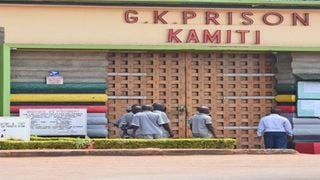
Inmates and correctional officers at Kamiti Maximum Security Prison in this picture taken on September 30, 2019.
| Evans Habil | Nation Media GroupNairobi
Premium
Manhunt as 3 terrorism convicts escape from Kamiti Maximum Prison
Security agencies say they have launched a manhunt for three terror convicts who escaped from Kamiti Maximum Prison on Sunday night.
Musharaf Abdalla Akhulunga, aka Zarkawi, aka Alex, aka Shukri, Mohamed Ali Abikar and Joseph Juma Odhiambo, aka Yusuf, are reported to have escaped the highly guarded facility after “removing part of the wall” leading to their cell block.
A Sh60 million bounty has since been on their heads for information leading to their arrest.
"The National Police Service informs members of the public that the three are dangerous and appeals for any information regarding their whereabouts," a statement from the Directorate of Criminal Investigations (DCI) reads in part.
However, questions have emerged on how the three managed to escape past the tall double perimeter wall surrounding the highly guarded security
Apart from the walls, there are several watch towers that have security personnel 24 hours.
“There was a hole in the room that housed the convict, but the unanswered questions are how they managed to go through the perimeter wall without anyone from the watch tower seeing them” a source at the prison told the Nation.
Kamiti is one of the most guarded prisons in the country as it is home to hardcore criminals.
After visiting the prison to establish the circumstances under which the three escaped, Commissioner-General of Prisons Wycliffe Ogallo in a statement said the three should not be given refuge by any member of the public.
“Anybody with information on the whereabouts of the above three named persons should report on this toll free number 99112 or the nearest security agency within reach,” Mr Ogallo said in a statement.
Musharaf was arrested on September 30, 2012 over his role in a foiled terror attack targeting Parliament Buildings.
He was charged with possession of explosives, ammunition and firearms. He hails from Ekero area in Mumias, Kakamega County.
Mohamed, an Islamist militant who was arrested following his involvement in the April 2, 2015 Garissa University attack, was serving a 41-year sentence.
He had been convicted alongside Hassan Edin Hassan and Tanzania’s Rashid Charles Mberesero, who was sentenced to life but committed suicide in November last year inside Kamiti.
His body was found in his ward hanging from a window grill with, a piece of blanket around his neck.
Prison authorities said the body had no visible injuries but that he was a psychiatric patient on medication.
Juma, who hails from Lukoye area, in Mumias, was arrested on November 21, 2019 in Bulla Hawa, Somalia, by Somali National Army personnel while attempting to enlist with the Al-Shabaab terror group.
Reports indicate that he had, alongside his co-suspect Idris Opwora Wesonga, were arrested close to the location where they were to be picked up by their host.
Back home, they denied three charges— including travelling to a terrorist designated country, failing to report their departure to an immigration office and exiting Kenya through an illegal point.
Mandera Senior Resident Magistrate Kimani Mukabi sentenced Odhiambo to 15 years in prison and Wesonga was jailed for 10 years.
Earlier on in 2015, he had been charged and convicted to six months’ imprisonment by a Garissa court for making another attempt to enter Somalia illegally.
The shocking escape of the three terror convicts happened barely days after the DCI declared missing ex-terror convict Egilva Bwire, Salim Rashid Mohammed, alias Chotara, and Barigi Abdikadir Haila as wanted men for allegedly planning undisclosed attacks in the country.
Early this year, a report by the National Strategy on Countering Violent Extremism(KNSCVE) pointed out prisons amongst potential locations for radicalisation to terrorism.
The report said some of the facilities provided convicted terrorists and their supporters with a potentially captive audience of disaffected individuals, free of distractions.
“Recruiters exploit the vulnerability of their fellow prisoners by offering prayers, psychosocial support, and financial assistance both during incarceration and after release,” the report states.





